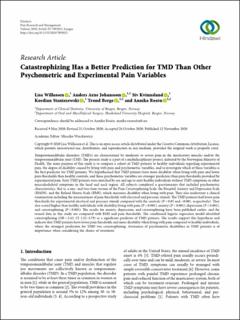| dc.contributor.author | Willassen, Lisa Celine Fjogstad | |
| dc.contributor.author | Johansson, Anders Arne | |
| dc.contributor.author | Kvinnsland, Siv Rosendorf | |
| dc.contributor.author | Staniszewski, Kordian | |
| dc.contributor.author | Berge, Trond | |
| dc.contributor.author | Rosén, Annika | |
| dc.date.accessioned | 2021-05-31T11:51:36Z | |
| dc.date.available | 2021-05-31T11:51:36Z | |
| dc.date.created | 2020-12-04T10:54:13Z | |
| dc.date.issued | 2020 | |
| dc.Published | Pain Research & Management. 2020, 2020:7893023 1-8. | |
| dc.identifier.issn | 1203-6765 | |
| dc.identifier.uri | https://hdl.handle.net/11250/2757068 | |
| dc.description.abstract | Temporomandibular disorders (TMDs) are characterized by moderate to severe pain in the masticatory muscles and/or the temporomandibular joint (TMJ). The present study is a part of a multidisciplinary project, initiated by the Norwegian Ministry of Health. The main purpose of this study is to compare a cohort of TMD patients to healthy individuals regarding experimental pain, the degree of disability caused by living with pain and psychometric variables, and to investigate which of these variables is the best predictor for TMD patients. We hypothesised that TMD patients have more disability when living with pain and lower pain thresholds than healthy controls, and those psychometric variables are stronger predictors than pain thresholds provoked by experimental pain. Sixty TMD patients were matched by sex and age to sixty healthy individuals without TMD symptoms or other musculoskeletal symptoms in the head and neck region. All subjects completed a questionnaire that included psychometric characteristics, that is, a one- and two-item version of the Pain Catastrophizing Scale, the Hospital Anxiety and Depression Scale (HADS), and the Roland Morris Scale (RMS), which measures disability when living with pain. They also underwent a clinical examination including the measurement of pain thresholds with electrical and pressure stimuli. The TMD patients had lower pain thresholds for experimental electrical and pressure stimuli compared with the controls (P < 0.05 and < 0.001), anxiety (P < 0.001), depression (P < 0.001), and catastrophizing (P < 0.001). The results for anxiety, depression, and catastrophizing have been published earlier, and the reused data in this study are compared with RMS and pain thresholds. The conditional logistic regression model identified catastrophizing (OR = 2.42, CI 1.22–4.79) as a significant predictor of TMD patients. The results support this hypothesis and indicate that TMD patients have lower pain thresholds and more disability when living with pain compared to healthy individuals, where the strongest prediction for TMD was catastrophizing. Awareness of psychometric disabilities in TMD patients is of importance when considering the choice of treatment. | en_US |
| dc.language.iso | eng | en_US |
| dc.publisher | Hindawi | en_US |
| dc.rights | Navngivelse 4.0 Internasjonal | * |
| dc.rights.uri | http://creativecommons.org/licenses/by/4.0/deed.no | * |
| dc.title | Catastrophizing Has a Better Prediction for TMD Than Other Psychometric and Experimental Pain Variables | en_US |
| dc.type | Journal article | en_US |
| dc.type | Peer reviewed | en_US |
| dc.description.version | publishedVersion | en_US |
| dc.rights.holder | Copyright 2020 Lisa Willassen et al. | en_US |
| dc.source.articlenumber | 7893023 | en_US |
| cristin.ispublished | true | |
| cristin.fulltext | original | |
| cristin.qualitycode | 1 | |
| dc.identifier.doi | 10.1155/2020/7893023 | |
| dc.identifier.cristin | 1856157 | |
| dc.source.journal | Pain Research & Management | en_US |
| dc.source.40 | 2020:7893023 | |
| dc.identifier.citation | Pain Research & Management. 2020, 7893023. | en_US |

